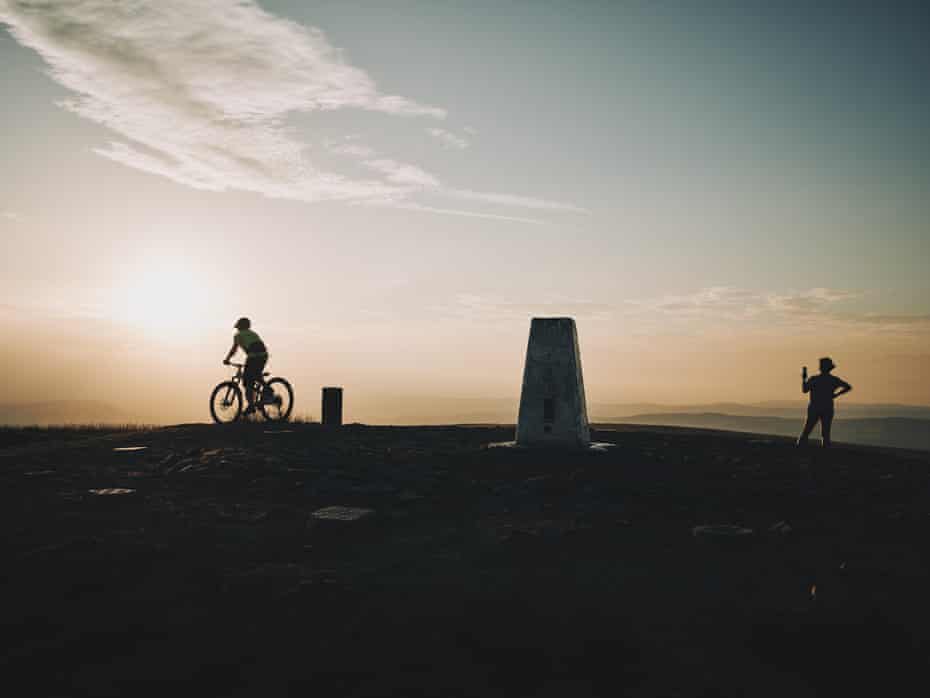Start Four Alls Inn, Higham, Lancashire
Distance 7 miles
Time 2.5 hours
Total ascent 533 metres
Difficulty Easy to moderate
Higham is a great place to start a walk, not too high, not too low. A few miles north of Burnley, it’s in the foothills at the southern edge of the eminence that is Pendle Hill. It’s a lovely corner, part of the Forest of Bowland area of outstanding natural beauty and much-loved by local residents, but nothing like as well known as the villages of Barley or Whalley.
This is sheep territory, so the land is mainly peeled back to basic green, but patches of native and semi-exotic woodland and rocky outcrops break up the contours. Those who have read any of the fictional or historical accounts of the 17th-century Pendle witch trials will know that this side of Pendle Hill was once the Forest of Pendle – an ancient hunting range between the Ribble and Calder valleys.
Google map of the route
Allow Google content?
This article includes content provided by Google. We ask for your permission before anything is loaded, as they may be using cookies and other technologies. To view this content, click ‘Allow and continue’.
Higham has just a sprinkling of new builds among the older terraces and remains a pretty village. The names of its two most famous residents were linked during the notorious trials. According to the testimony of Alizon Device (granddaughter of the alleged Pendle witch known as Demdike), a local matriarch, Anne Whittle (AKA Chattox), quarrelled with yeoman farmer John Moore, who accused her of turning his ale sour.

Device also claimed that Chattox had used a familiar (a spirit) to bite one of Moore’s cows, which had subsequently gone mad and died, and that she carried a clay image of Moore’s young son – who fell ill and died. Chattox was hanged at Gallows Hill in Lancaster on 20 August 1612.
Another of Moore’s sons is the other notable resident. Jonas Moore, born in 1617 in a house called Higher White Lee in Higham, was educated locally but went on to become an influential mathematician, civil engineer, ordnance officer and – as a member of the Royal Society – patron of astronomy. There’s a downloadable short walk around landmarks associated with Moore and Chattox.
For our longer, loftier hike, we leave Higham on the northbound Pendle Way, a 45-mile circular loop. This section is well signposted (look out for the little witches on broomsticks), all the way to Newchurch. It’s a slow climb though fields and along quiet lanes; hairy ponies, cattle and goats share the grazing with the sheep. Newchurch is worth a brief stop: Saint Mary’s churchyard contains the headstone of the Nutter family, who were probably linked with Alice Nutter, another victim of the Lancashire witch-hunt. Spookily, the top of the grave is etched with a skull shaped like Edvard Munch’s Scream.

From Newchurch (where there is a public toilet), we veer off the Pendle Way to go north-west, taking steep steps and a diagonal traverse up to an exposed brow, from which there is a series of increasingly stupendous views of Pendle Hill’s Big End. You’ll see the two paths that weekend walkers take to climb the best-known face and can congratulate yourself on being more original and, almost certainly, completely alone up here. I keep glancing over the drystone walls to watch how the cloud and sunlight dance along the dramatic slopes of Pendle Hill.
Quick Guide
Saturday magazine
Show

This article comes from Saturday, the new print magazine from the Guardian which combines the best features, culture, lifestyle and travel writing in one beautiful package. Available now in the UK and ROI.
Directly east is a much lower tump, topped by a column. That is Blacko Hill and on its summit is Stansfield Tower – which was built by a local grocer at the end of the 19th century, either to get a better view over to the West Riding of Yorkshire or, as some claim, to impress a local woman. The folly fell short on both counts.
Take a sharp right at Fell Wood to start descending. The footpath leads through a dark, moody plantation of spruce and pine trees that’s more Dracula than Pendle Witches. Nuthatches, which have amazing agility on vertical trunks, and blue tits flit through the wood, though you’re more likely to hear the wind whistling than birdsong.

You’ll have caught a few glimpses of water by this stage and as you leave the shade of the conifers will find yourself at the end of Lower Ogden reservoir. It was built in 1914 to supply water to Nelson, which had grown from a small village into a town of about 40,000 souls over the previous century.
Cross the bridge and wind round to the west. The cleft in the hills where the water flows between the reservoirs is well wooded, with two further forested areas, Buttock Plantation and Blue Wood, providing cover for picnics. There are lots of butterflies and birds.
Climb some steps up to the smaller, but technically impressive Upper Ogden reservoir – built in 1906 – and continue up the steep hill south of the dam. From here there are broad views over Winter Hill – with its TV mast – and the moorland windfarms of Scout Moor and Hyndburn. If not as picturesque as Pendle Hill, the sight is nonetheless one to behold. A look at OS map 21 shows how built up the rest of East Lancashire is; surely the Bowland/Pendle AONB is a worthy candidate for the recently announced national parks programme?

The return to Higham is an enjoyable, breezy hop-and-skip drop down through fields, with the option of one more woodland traverse at Cock Clough (go on, you may as well, if only so that you can recount enjoying views of both Cock and Buttock) to Sabden Fold. From here, there are several routes back to Higham.
Lancashire has more footpaths than many counties, thanks to centuries of working people using field tracks to get to mills, mines and barns (though there are concerns that some are being lost thanks to lack of funding and local authorities’ failure to register paths) and there are always options.
The Four Alls Inn awaits at the foot of the hill with refreshments and outdoor tables; if a crone offers you a glass of something sour before you get there, just say no.
The pub

Pendle Hill is ringed by ye olde pubs, new pubs, pubs with posh rooms, pubs with tourists and pubs with fancy food. The Four Alls in Higham is a proper pub, specialising in being a pub. It has a saloon bar. It has four ales on tap (Moorhouses’ White Witch, Inferno, Prospect’s Silver Tally, Filly Close Blonde) at £3.20 a pint. Lager, wine and soft drinks are available, and the grub is honest and excellent, especially the Lancashire hotpot – a rich dark sauce, buttery-soft meat, creamy potatoes. There are roasts on Sundays (three courses £17.95). Decor is plain and modern, but there are a few old pictures and a glass etching explaining the pub’s curious name.
Where to stay
As the pub has no rooms, cross the ridge above Sabden (by foot, bike or car) and descend to Downham for equally spectacular views of Pendle Hill. Greendale View Kitchen, a pitstop for cuppas and cakes, is also an excellent bed and breakfast, with a posh suite, two smart doubles and a twin. The handsome stone house is on the road to Chatburn (with footpaths in several directions), and the Rutherford family specialise in local, organic grub.
Doubles, with delicious full breakfast, from £70





